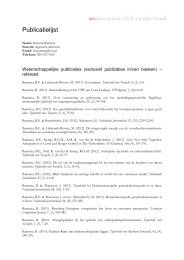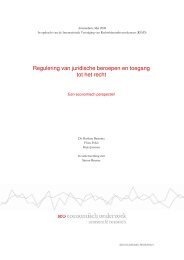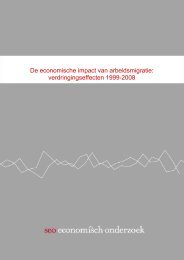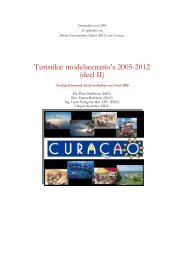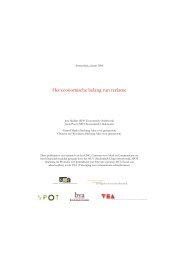Amsterdam, Netherlands - SEO Economisch Onderzoek
Amsterdam, Netherlands - SEO Economisch Onderzoek
Amsterdam, Netherlands - SEO Economisch Onderzoek
You also want an ePaper? Increase the reach of your titles
YUMPU automatically turns print PDFs into web optimized ePapers that Google loves.
field of the HEIs will be increasingly international rather than regional. This emerges due toincreased student and worker mobility in the globally competitive world. A world class globalbusiness gateway requires world class higher education and research. The knowledge base for thistype of institutions is worldwide and would be impossible to develop on the basis of scientificresearch from the region alone.In global competition skill biased economic growth is likely to cause a dual labor market withdifficult labor market prospects for the lower educated and relatively better income opportunitiesfor the higher educated. The social problems emerging from this situation will require anadequate response from the regional community. The need for more effective regional learningsystems is met by projects and initiatives emerging bottom-up. The HEIs must play a role in thisapproach together with schools at the secondary level. Regional public authorities will probablyfacilitate this process but lack the means to offer extensive financial stimulus. Most likely privatepartners step in recognizing the need to secure a dynamic labor market in the region with asufficient supply of workers and graduates with higher education.The cultural sector in the <strong>Amsterdam</strong> metropolitan area is likely to prosper in the globalcompetition scenario. The economy draws highly educated workers to the region which form theaudience for the growing number of seats in theatres and concert halls. This in turn draws privateinvestors to the sector which helps maintain the infrastructure needed in this sector. As a spin-offthe creative sector will develop into a cluster with large economic potential for the region.Rapid growth in the world economy in this scenario intensifies the need for sustainabledevelopment. But the steps forward in this direction are frustrated by the lack of internationalcooperation and regulation. This undermines the economic prospects for a sustainability cluster inthe <strong>Amsterdam</strong> region and means that the cooperation between the HEIs in this field needs to bestrengthened bottom-up.Table 7-1 below summarizes the two possible action plans for the <strong>Amsterdam</strong> metropolitan area.7.4.5 ConclusionScenario’s like the ones discussed in this closing chapter present policy makers with largelyexternally driven developments like the intensity of international competition. These are givenswhen it concerns the development of a regional plan of action for social and economicdevelopment. However, modern theory teaches us the importance of a proactive approach to theagenda for city and regional development. The reasons for doing so are the following.First, many determining factors for economic growth are location-specific: This is the lessonfrom urban economics and geographical economics (Krugman, 1998; Brakman, Garretsen andvan Marrewijk 2001). Cities emerge partially as a result of a clustering of economic activity. Thisclustering arises because firms and industries reap economic benefits from their mutualproximity. We call these benefits agglomeration effects which are made up of external economiesof scale like the existence of a large local market for specialized inputs and labor market pooling.On the demand side the love-of-variety in a large local market plays a role.Second, the literature of endogenous economic growth underlines the crucial role of increasingreturns to scale in the process of economic growth (Romer, 1986). The importance of this findingis that it makes cities and regions at least partly the director of their own economic success. Theycreate the conditions under which the externalities or spillovers of local economic activity can beinternalized, that is, used to the benefit of a still faster process of economic growth. In a nutshell,the concentration of economic activities in urban centers creates local spillovers likes the onesmentioned above, which foster the accumulation of human capital and so aids economic growth.In turn economic growth affects the patterns of urbanization which makes the whole process acycle of interrelated activities which we call endogenous economic growth. Black and Henderson(1999) stress that regional authorities may act as a catalyst in this endogenous process of growth,136






